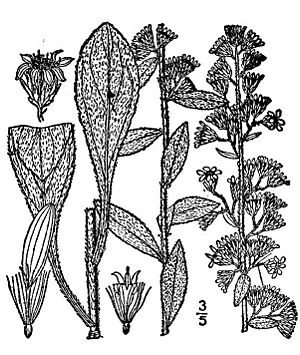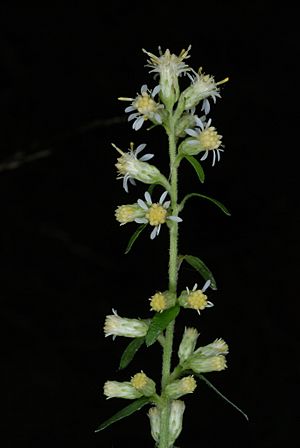Solidago bicolor facts for kids
Quick facts for kids Solidago bicolor |
|
|---|---|
 |
|
| 1913 illustration | |
| Scientific classification | |
| Genus: |
Solidago
|
| Species: |
bicolor
|
Solidago bicolor, also known as white goldenrod or silverrod, is a type of plant found across eastern North America. In the Canadian province of Québec, it is sometimes called verge d’or bicolore. This plant grows naturally in many parts of Canada, from Manitoba to Nova Scotia. In the United States, you can find it in almost every state east of the Mississippi River, except for Florida. It likes to grow in sandy and rocky soils and is often seen along the sides of roads.
About White Goldenrod
The white goldenrod is special because it looks different from other plants in its group, the Solidago genus. Most goldenrod plants have yellow flowers, but the Solidago bicolor has white flowers. Its stems are thin and look a bit like wire.
What It Looks Like
Unlike many other goldenrod plants that have their flowers in a big cluster at the very top, the white goldenrod's flowers are mostly grouped closer to the leaves. They are found in the "axils" of the leaves, which means where the leaves meet the stem. This unique way of growing its flowers, along with their white color, helps you tell it apart from its yellow-flowered relatives.
Where It Grows
This plant is very good at growing in places where the soil is sandy or rocky. It doesn't need very rich soil to thrive. Because it can grow in these tougher conditions, you often see it growing happily along roadsides or in open, disturbed areas. It's a hardy plant that can adapt to different environments within its native range.


